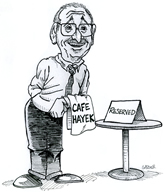The goal of tariffs, in part, was to raise manufacturing employment. Given that more than half of U.S. imports consist of intermediate goods — inputs used by American manufacturers — these tariffs inevitably raise production costs. That alone should make the trend of a weakening manufacturing sector unsurprising. New data show that 58,000 manufacturing jobs have been lost since “liberation day.” Other forces are at play, of course, but one thing is clear: Since 2016, the trend line has not moved in the direction populists promised it would. Manufacturing losses are accelerating, and the United States is losing blue-collar jobs, not adding them.
David Henderson explains with enviable clarity why “trade deficits aren’t a problem.” A slice:
Not only is there no reason to have a zero trade deficit with a particular country but also there’s no particular reason to have a zero trade deficit with the world. Herb Stein was chairman of the Council of Economic Advisers under President Nixon and, incidentally, one of the best bosses I ever had in my first stint with the Council, as a summer intern in the summer of 1973. Stein had a way with words and well understood the economics of balance-of-payments deficits. That’s why I commissioned him to write the entry titled “Balance of Payments” in my Fortune Encyclopedia of Economics, which later became The Concise Encyclopedia of Economics. His entry led off as follows:
Few subjects in economics have caused so much confusion—and so much groundless fear—in the past four hundred years as the thought that a country might have a deficit in its balance of payments. This fear is groundless for two reasons: (1) there never is a deficit, and (2) it would not necessarily hurt anything if there was one.
How could Herb Stein say that there never is a deficit? The reason is that he considered the overall balance of payments, which includes both the current account and the capital account. The current account is composed of three types of income: (1) the trade deficit or surplus; (2) the income on investments abroad minus foreigners’ income on US investments; and (3) transfers, such as aid and remittances, to the United States from other countries minus such transfers from the United States to other countries. In 2024, the current account deficit was $1.13 trillion. The obverse of a current account deficit is a capital account surplus. When we have a current account deficit, foreigners end up with dollars. What do they do with these dollars? They use them to buy bonds, typically US government bonds, to buy stock in US companies, to buy US land, and to engage in direct investment, that is, producing capital such as manufacturing facilities in the United States. As an accounting necessity, the balance of payments, which includes the current account and the capital account, is zero.
Also, because the US dollar is the closest thing there is to an international currency, some foreigners simply hold on to the dollars. Is that a problem? It’s the opposite of a problem. According to the Federal Reserve Board of Governors, the cost to the US government of printing a $100 bill is less than 12 cents. So for a cost of under 12 cents we get $100 in goods and services. It is true that then those dollars are no longer in the US economy. But there’s an easy fix. The US government can print more. It’s like the 1989 ad that Jay Leno made for Doritos: “Crunch all you want; we’ll make more.” And if the government does not print more, foreigners holding on to their dollars they got from selling us goods and services cause there to be fewer dollars than otherwise circulating in the US economy. That means that prices are somewhat lower than otherwise. So if prices would have risen by, say, 3 percent, approximately the current annual increase of the Consumer Price Index, they would rise by slightly less, say 2.9 percent. That means that our dollars go slightly further in purchasing power.
The problem isn’t that industrial policy has been done badly. It’s just bad economics.
Dreams of reviving manufacturing jobs face the reality that modern manufacturing is capital-intensive and largely automated. Even if subsidies or government loan guarantees spur a factory boom—and history suggests otherwise—it won’t bring back 1950s-style armies of industrial workers unless we somehow outlaw productivity. Today’s factories run on robots and engineers.
Nor will tariffs bring a manufacturing revival. Taxing inputs and components only raises costs, weakens U.S. competitiveness, and ultimately punishes the firms protectionists claim to support. True American industrial strength rests on productivity, innovation, competition, and access to global supply chains, not on coddling producers behind walls of higher prices.
[Mariana] Mazzucato and her ideological opposites commit the same error. They imagine a politics-free technocracy that can “direct” the economy. In the real world, politics always dominates economics. Subsidies and tariffs are never tools of neutral expertise; they are invitations to lobby. Every “strategic investment” quickly becomes a political IOU.
Richard Baldwin tweets: (HT Scott Lincicome)
My new Factful Friday is up on Substack (free); on LI tomorrow as usual.
👉 Did US tariffs on China end up protecting exporters from Mexico?
👉 Trumpian tariffs were supposed to
1) protect American firms by raising import prices inside the US;
2) lower import prices at the border by forcing foreigners to “eat” part of the tariff.
👉Part 1 happened. Part 2 didn’t; border prices actually rose.
Today’s Factful Friday explains why.
⭐ The 50%+ tariffs crushed Chinese competitiveness inside the US. This shielded US manufacturers.
GMU Econ alum Jon Murphy rightly insists that “strong claims need strong evidence.”
In recent pieces for Law & Liberty, legal scholar Robert Natelson and historian Paul Moreno have defended originalism against Lepore’s “constitutional despair.” It is safe to say that, unlike the more rigorous work of her colleagues, her jeremiad fails to meet standards of scholarship, as it distorts quotations out of context, misstates facts, and confuses concepts. And its central thesis—that originalism thwarts constitutional change and kills the amendment process—gets matters precisely backward.
Properly understood, originalism preserves the Constitution and its Article V amendment process, the lawful mechanism for change that a constitutional republic requires. By distinguishing between judicial and political processes, originalism provides a vital framework for protecting the democratic legitimacy, popular sovereignty, and the formal amendment machinery at the heart of the American Founding.
Thomas Howes decries “the mainstreaming of Carl Schmitt’s authoritarianism.”
Emmanuel Rincon is correct: “Sanctions didn’t destroy Venezuela’s economy — socialism did.”



